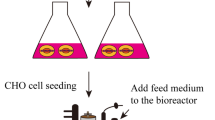Abstract
The aim of this study was to improve the survival ofNIH3T3 cells in low serum or serum-free media by theendogenous expression of recombinant bFGF (basicfibroblast growth factor) and/or IGF (insulin-likegrowth factor) -I and II. Expression was detected byWestern blotting, and the growth characteristics ofdifferent transfected cell lines investigated in bothserum-free and low serum conditions and also in softagar. Morphological changes and the growth rate werecompared with growth in normal serum-containingmedium. The experimental data suggested that theexpression of either bFGF alone, or the co-expressionof bFGF and either IGF-I or II could improve thesurvival of NIH3T3 cells in low serum or serum-freemedia. The use of such lines could decrease the use ofserum in cell culture and thus both reduce the costsinvolved in this technique and simplify thedown-stream purification procedure in protein harvest.Hence, such lines may be of value in both experimentaland industrial applications.
Similar content being viewed by others
References
Bjare U (1992) Serum-free cell-culture. Pharmacol Ther 53: 355-374.
Conover CA, Rosenfeld RG & Hintz RL (1989) Serum glucocorticoids have persistent and controlling effects on insulin-like growth factor-I action under serum-free assay conditions in cultured human-fibroblasts. In Vitro Cell Dev Biol 25: 521-527.
Cullen KJ, Lippman ME, Chow D, Hill S, Rosen N & Zwiebel JA (1992) Insulin-like growth factor-II overexpression in MCF-7 cells induces phenotypic changes associated with malignant progression. Mol Endocrinol 6: 91-100.
Froger-Gaillard B, Hossenlopp P, Adolphe M & Binoux M (1989) Production of insulin-like growth-factors and their bindingproteins by rabbit articular chondrocytes-relationships with cell multiplication. Endocrinol 124: 2365-2372.
Gordon PR, Mansur CP & Gilchrest BA (1989) Identification and isolation of a bovine brain derived growth-factor for human keratinocytes. J Invest Dermatol 92: 565-572.
Halaban R, Ghosh S & Baird A (1987) bFGF is the putative natural growth-factor for human melanocytes. In Vitro Cell Dev Biol 23: 47-52.
Hirobe T (1992) Basic fibroblast growth-factor stimulates the sustained proliferation of mouse epidermal melanoblasts in a serum-free medium in the presence of dibutyryl-cyclic-amp and keratinocytes development. Development 114: 435-445.
Kemp SF, Kearns GL, Smith WG & Elders MJ (1988) Effects of IGF-I on the synthesis and processing of glycosaminoglycan in cultured chick chondrocytes. Acta Endocrinol 119: 245-250.
Kitchens DL, Snyder EY & Gottlieb DI (1994) FGF and EGF are mitogens for immortalized neural progenitors. J Neurobiol 25: 797-807.
Li DJ (1997) Studies on the expression of bFGF and IGF-I and-II in 3T3 cells. PhD thesis, University of Paisley.
Macaulay VM (1992) Insulin-like growth-factors and cancer. Br J Cancer 65: 311-320.
Miller AD & Rosman GJ (1989) Improved retroviral vectors for gene-transfer and expression. Biotechniques 7: 980-988.
Schechter R, Whitmire J, Beju D, Jackson KW, Harlow R & Gavin JR (1995) An immunohistochemical and in-situ hybridization study of insulin-like growth-factor-I within fetal neuron cell-cultures. Brain Res 670: 1-13.
Singleton JR, Randolph AE & Feldman EL (1996) Insulin-like growth-factor-I receptor prevents apoptosis and enhances neuroblastoma tumorigenesis. Cancer Res 56: 4522-4529.
Taylor AM, Dandona P, Morrell DJ & Preece MA (1988) Insulin-like growth factor-I, protein kinase-C, calcium and cyclic-AMP-partners in the regulation of chondrocyte mitogenesis and metabolism. FEBS Lett 236: 33-38.
Vetter U, Zapf J, Heit W, Helbing G, Heinze E, Froesch ER & Teller WM (1986) Human-fetal and adult chondrocytes-effect of insulin-like growth factor-I and factor-II, insulin, and growth-hormone on clonal growth. J Clin Invest 77: 1903-1908.
Yang D, Faris R, Hixson D, Affigne S & Rogler CE (1996) Insulinlike growth-factor-II blocks apoptosis of N-myc2-expressing woodchuck liver epithelial-cells. J Virol 70: 6260-6268.
Author information
Authors and Affiliations
Corresponding author
Rights and permissions
About this article
Cite this article
Li, D., Hettle, S., McLean, J. et al. Survival of 3T3 cells expressing or co-expressing bFGF and/or IGF-I and/or IGF-II in low serum and serum free media. Cytotechnology 32, 209–218 (2000). https://doi.org/10.1023/A:1008151302358
Issue Date:
DOI: https://doi.org/10.1023/A:1008151302358




